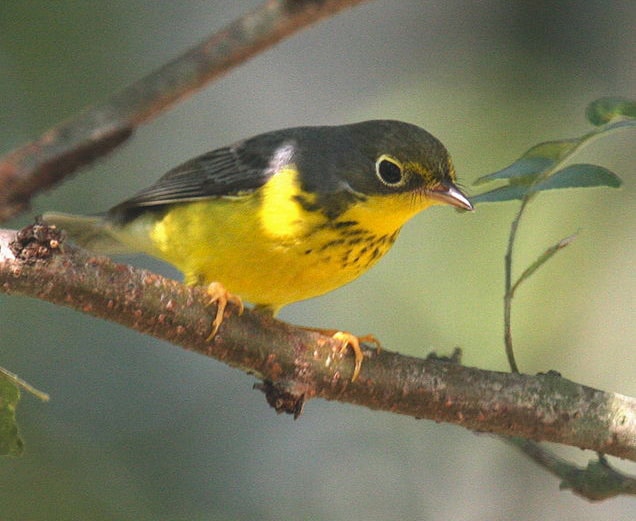1. Snow goose
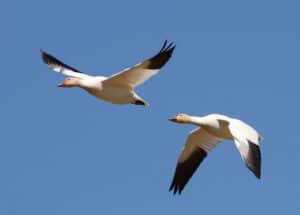
One of the more spectacular bird-watching sights to see in Kentucky is a whirling hurricane of Snow Geese. In order to witness this breathtaking sight, you must visit the far western counties of the state, where the Mississippi Flyway serves as a funnel for large numbers of waterfowl. There are three places in Kentucky that host large flocks of geese, including snows.
Sloughs Wildlife Management Area in Henderson County, Ballard Wildlife Management Area in Ballard County, and the Long Point Unit of Reelfoot National Wildlife Refuge in Fulton County. Numbers of geese are typically greater at the latter two locations. Midwinter is the best time to see snow geese wintering in Kentucky, but sizable flocks can appear any time from latter November to mid-March. If you decide to plan a trip to see geese in winter, monitor the BIRDKY listserve beforehand to see where flocks are being observed most reliably.
One nice aspect of our flocks of snow geese is that there is a generous mixture of both white and blue “morphs.” This combination adds another dimension to the swirling flocks of birds. A day with a little snow cover and a bright blue sky can yield some of the most pleasing images you’ll ever witness if you can view the flocks in the right light.
2. American white pelican
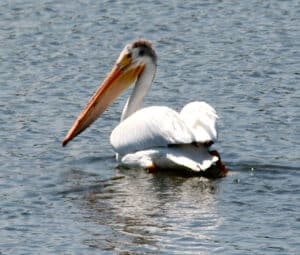
Although American white pelicans were a rare transient through Kentucky in historical times, it’s only in the past 20 years that we have begun to see regularity to their occurrence and a great increase in their numbers. Today the birds are most reliable from Lake Barkley, westward, but a few wander eastwards every year. Nowadays, flocks of pelicans floating along lazily over the vast waters of Lake Barkley and Kentucky Lake are a common sight, especially in March and April and again from late October to mid-December.
American white pelicans are the largest birds to occur in Kentucky, with a wingspan of 8 feet and an average weight of more than 15 pounds! Pelicans often use thermals–rising columns of warm air–to attain great heights from which to migrate or move from one feeding area to another. Since 2002, several dozen American white pelicans have used the tailwaters of Barkley Dam for feeding each day from late March to mid-April, affording wonderful views of these spectacular waterbirds. Other places that often host some pelicans include Ballard Wildlife Management Area (Mitchell Lake), and isolated sandbars and river sloughs from Carlisle, Hickman, and Fulton counties.
3. Sandhill crane
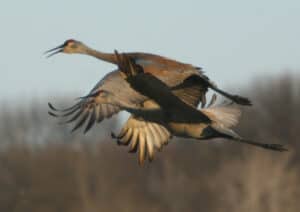
One of the real birding treats afforded central Kentucky residents each spring and fall is the passing of migrant flocks of sandhill cranes. These birds are moving between breeding grounds in central Canada and the northern Great Lakes states and wintering grounds in the southeastern United States, especially central Florida. Interestingly, cranes are creatures of habit, and their migratory corridor through Kentucky takes most birds on a path between Lexington and London on the east and Owensboro and Bowling Green on the west.
Smaller number of birds cross the state farther east and west, but the vast majority follow this relatively narrow corridor. Some of the areas where cranes are most regularly observed include Jefferson County, farmland west of Elizabethtown, Barren River Lake and Green River Lake, and the Transient Lakes in southern Warren County. Although cranes have been seen in every month except July, peak numbers occur from mid-February through mid-March and again from mid-November to late December. There are now even a few that appear to overwinter in open farmland of southern Kentucky.
Many people mistake flocks of cranes for geese, but sandhill cranes can be easily identified in several ways. First, in addition to having long necks that protrude well in front of their bodies and wings, cranes also have long legs that dangle behind them in flight. The gutteral, rolling calls of cranes are quite unlike the honks or barks of geese. Finally, unlike geese, flocks of cranes utilize thermals or crosswinds to help them gain elevation, so they often stop to circle, gaining altitude for several minutes. When they have achieved their preferred height to migrate on, they reform into “Vs” and proceed on north or south, gradually losing altitude until they decide to break up and circle again to start the cycle over.
4. Solitary sandpiper

Kentucky hosts a considerable variety of migratory shorebirds, although you must usually make a special effort to see most of them. As many as 12 to 15 species may be seen in a single day by carefully covering hotspots for them, but one of the most widespread is the solitary. This is because the solitary will stop in on just about any small- to medium-sized body of water that has a bit of muddy, grassy, or sandy shoreline on it. These include small streams, farm ponds, and pools present from excessive rains. It also occurs just about as commonly on these habitats in eastern Kentucky as in the western portion.
As shorebirds go, the solitary is a medium-sized one. It has a relatively short, slim bill and legs that are typically olive colored. The upperparts are dark, charcoal with light markings, and the distinctive tail pattern is dark in the center with bands of light and dark color on the sides. Several smaller species are especially difficult to tell apart and are collectively known as “peeps.”
Species that are much larger than the solitary are not that numerous, but occur seasonally and include the greater yellowlegs. Keep a watchful eye on open shorelines and flats for any of these species. Most occur from mid-April to mid-May and again from early August to mid-October. The best concentrations will occur along the margins of receding floodwaters in western Kentucky farmland in spring. In fall, the receding shorelines and flats of the larger reservoirs and rivers provide the best habitat.
5. Least tern
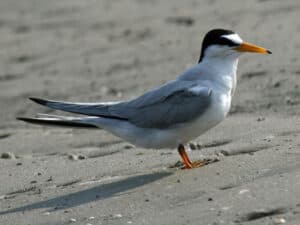
Kentucky hosts only one species of federally endangered bird, the least tern. These small waterbirds are found on the larger lakes and rivers, and along the lower Ohio River around Paducah, and along the entire stretch of the Mississippi River that bounds western Kentucky. These smallest of terns are mostly white, with pearly gray backs, black caps with a white forehead, and yellow bill.
Least terns are most common along our country’s coastlines, but a population nests on river bars of the interior of the United States. These birds are present in our area from mid-May to early September. Nests are simply shallow depressions in the sands of open sandbars on the river, although less suitable sites like sandy points in flooded agricultural fields are sometime chosen. Two or three eggs are normally laid in late May or June, and the young fledge by early August.
Least terns are relatively hard to find in Kentucky, but their graceful appearance and rarity make them worthy of seeing. Some of the best places to find these birds include sandbars below Smithland Dam (viewed from the riverfront at the town of Smithland); on Mitchell Lake at Ballard Wildlife Management Area; along the Mississippi River in the vicinity of the Laketon public boat ramp (Carlisle County); at Westvaco Wildlife Management Area (Hickman County), and near or downstream from the town of Hickman (Fulton County).
6. Rufous hummingbird

For many years, Kentucky could only be said to host one species of hummingbird, the ruby-throated. However, since the mid-1980s, another species has become quite regular in small numbers during the fall, with a few lingering into winter. This is the rufous hummingbird of the western United States and Canada. A few move into the southeastern United States in fall instead of heading into Mexico for the winter. Birds have showed up all across the western two-thirds of Kentucky, but their distribution may be due more to the number of feeders present than to any other factor.
Rufous hummingbirds have a strong wash of buff color on their sides and bright rufous in the spread tail. A few birds are adult males, which are immediately noticeable because of their bright rufous upperparts. Most rufous hummingbirds appear in late September and October, just about the time the last of our ruby-throateds are departing. Most individuals that do show up about that time appear to linger into winter and feeding them can become a challenge.
Rufous hummingbirds are VERY hardy, however, and most seem to easily handle temperatures into the single digits if you can keep their sugar water free of ice. This becomes the key, however, and care must be taken to provide a source of warmth for the feeder (most people use floodlights or heat lamps that are set up close to the feeder and pointed directly at it).
In addition to rufous hummingbirds, several other species of western and tropical hummers have shown up in the eastern United States. Most occur in fall and winter, so if you see a hummingbird anytime after mid-October, contact your local bird club leaders to let them know you might have a rarity!
7. Common raven
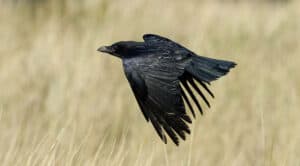
Perhaps Kentucky’s rarest resident bird–and our largest corvid–is the common raven. At the time of European settlement, ravens likely occurred locally across the entire state, but as humans became more common, ravens retreated into the most remote portions of the southeastern mountains. There were many decades when the raven was unknown in Kentucky. Beginning in the late 1960s, a few ravens returned to the rugged mountains of eastern Kentucky, and the population has slowly expanded in subsequent years.
Nowadays, you have a reasonable chance of seeing common ravens at several spots in southeastern Kentucky including most anywhere along Pine Mountain from Pine Mountain State Resort Park to Blanton Forest State Nature Preserve, Kingdom Come State Park, Bad Branch State Nature Preserve, and Breaks Interstate Park. A few birds are also regularly observed at Black Mountain and Cumberland Gap National Historical Park.
The croaking, rattling calls of ravens are just about as interesting to encounter as the image of these all-black birds gliding over the mountains. Birds are probably hardest to find during the breeding season, when they stay close to their nests (March through May) and easiest to encounter during fall and winter when the forage and wander more widely.
8. Prothonotary Warbler
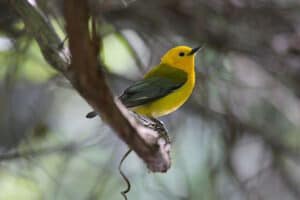
Among Kentucky’s nesting warblers, one of the most beautiful and conspicuous is the prothonotary. It is hardly ever seen in the eastern portion of the state, but it makes up for its scarcity in the east by its abundance in the west. The species is present along the larger rivers and reservoirs of central Kentucky, but it becomes more and more common as you head west. By the time you reach the Land Between the Lakes region, it is a common summer resident of any wetland habitat type, from stream corridors to reservoir shores and river sloughs.
Prothonotaries are not only conspicuous because of their gaudy plumage, but also their loud sweet, sweet, sweet, sweet song, which rings through bottomland habitats from the time they arrive in mid-April until they complete the nesting cycle in mid-July. They nest in cavities, usually quite low to the ground or water, so they often accept nest boxes if they are placed near water.
9. Kentucky Warbler
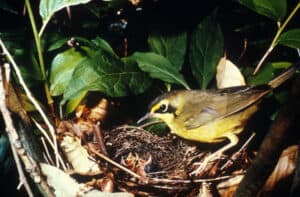
The state’s namesake songbird is not as easy to find as the prothonotary, but it is nearly as common and is more widely distributed across the state from east to west. Kentucky warblers inhabit forest habitats, and they are most common in moister forest situations where there is a relatively dense shrub layer.
A portion of the scientific name of the Kentucky warbler is formosus, which in Latin means “beautiful,” and that it is. Bright yellow underparts yield to olive green upperparts and a bold black-and-yellow face pattern is quite distinctive. However, to get a look at a Kentucky warbler good enough to appreciate that beauty is another matter.
In fact, despite its overall abundance, there may be no other breeding warbler in Kentucky that is heard so often but seen so seldom! Patience is generally the key, and if you can recognize its loud, ringing turtle-turtle-turtle-turtle song in the woods, a slow approach will typically yield nice looks.
Kentucky warblers are present in Kentucky from about the third week in April to the middle of September. Good places to hunt for them include Mammoth Cave National Park and Bernheim Forest (Bullitt and Nelson counties).
10. Baltimore Oriole
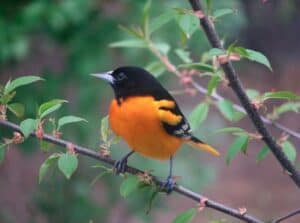
One of Kentucky’s brightest avian attractions has to be the male Baltimore oriole. Slightly smaller than a robin, this oriole’s bright orange-and-black pattern makes it a joy to see. And many residents of north-central Kentucky, where the species is most abundant as a nesting bird, also recognize its cheerful song. Baltimore orioles prefer open, park-like habitats with large deciduous trees interspersed with open areas. For this reason, they are quite commonly encountered in residential areas.
Baltimore orioles spend the winter in the tropics, and they return to Kentucky during mid-April. It is at this time when the species is most widespread. After mid-May, only nesting birds are present until early fall, and the species is not common everywhere. In fact, it is quite locally distributed across much of eastern and southern Kentucky, occurring in those regions mostly along rivers. The Baltimore oriole’s nest is about as unique as its own appearance, being a finely woven hanging basket of grass that is often attached conspicuously to a long outer branch of a large shade tree.
The best places to search for Baltimore orioles are parks in north-central Kentucky, especially if there is a lake or river nearby. Listen for their slurred musical songs in tall trees, where they forage out near the tips of the branches. You may even attract an oriole to your yard by offering orange halves impaled on tree branches.


